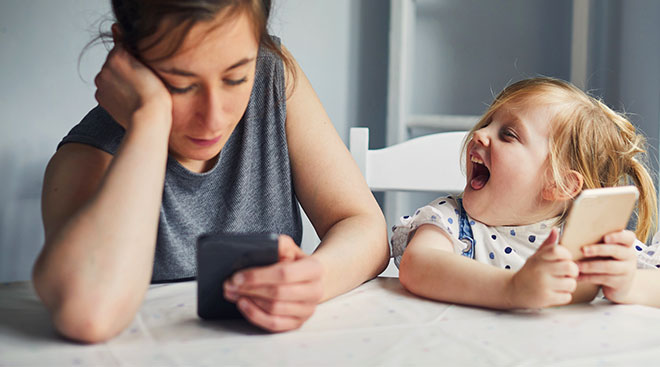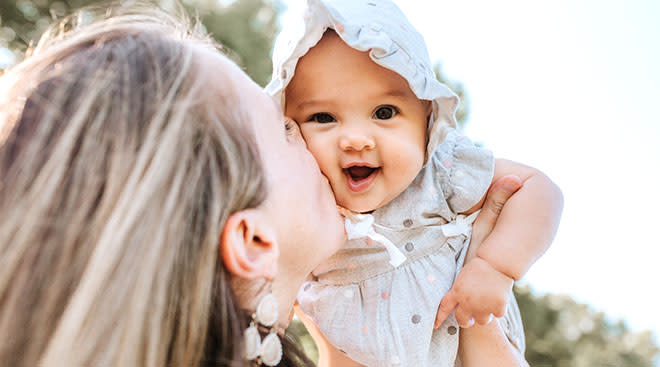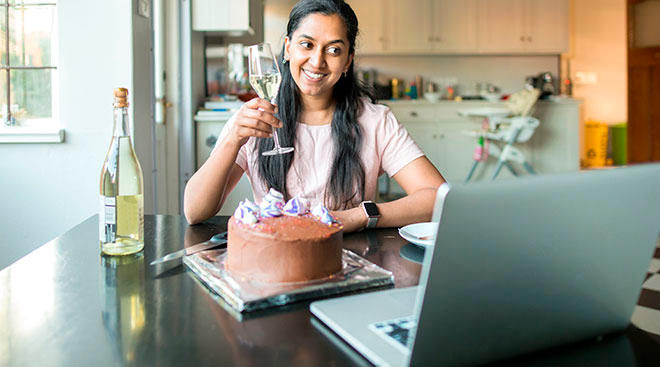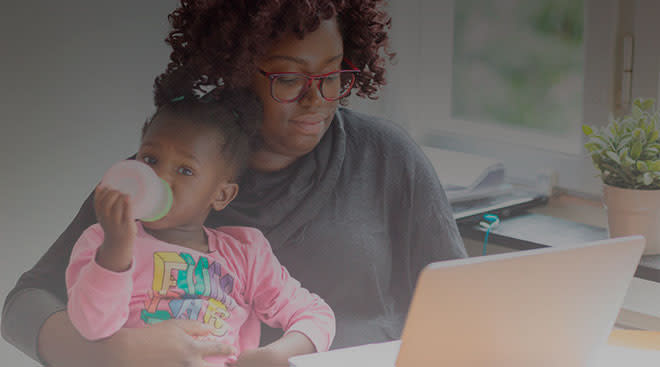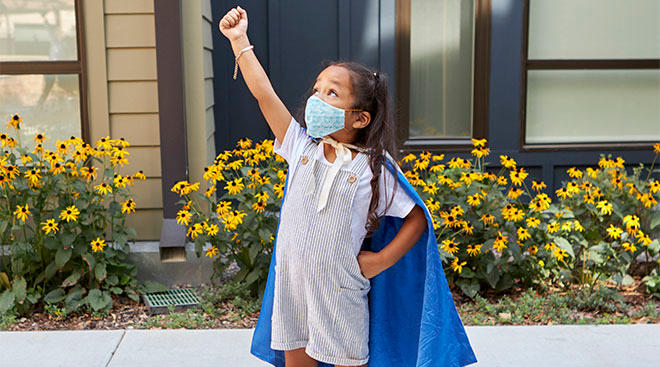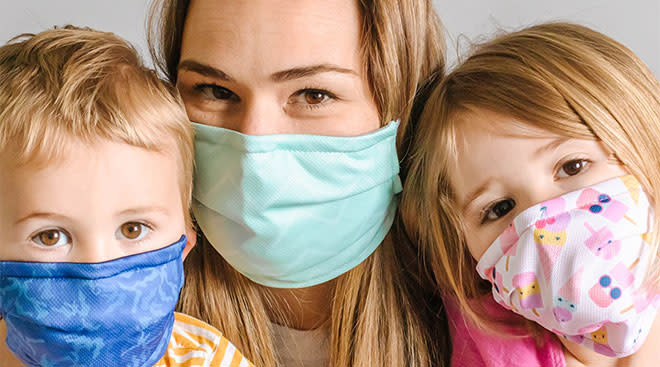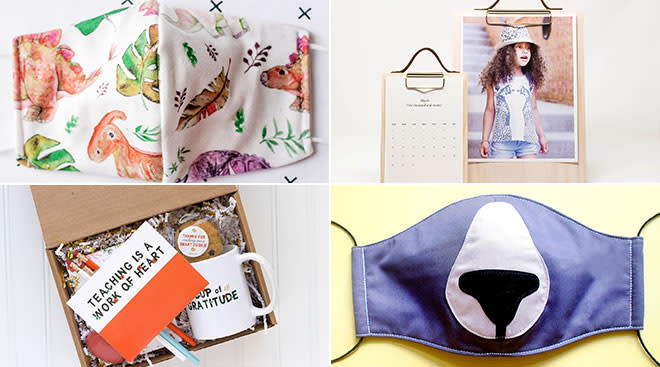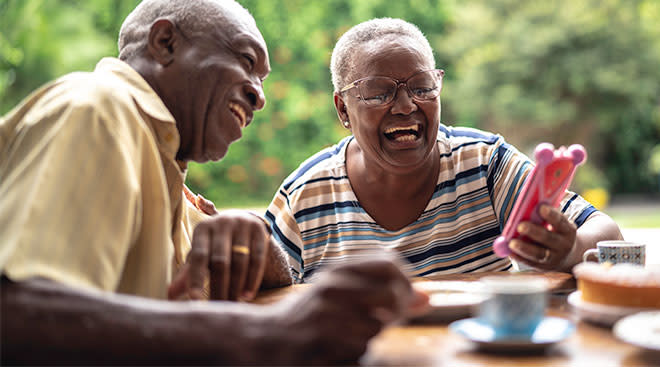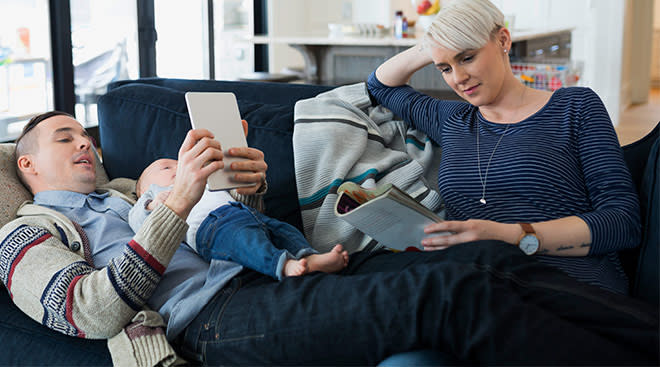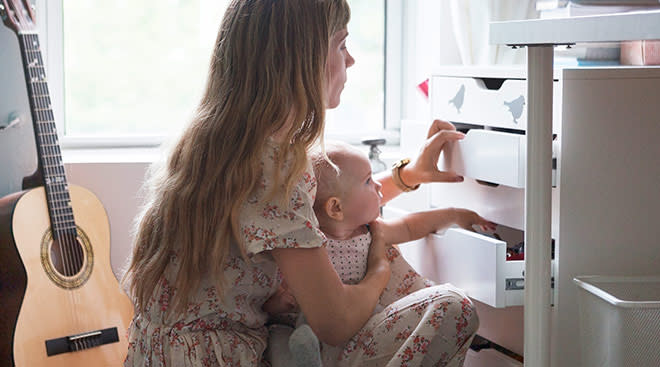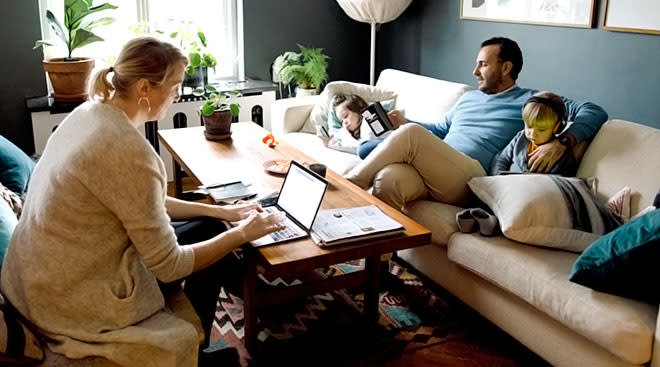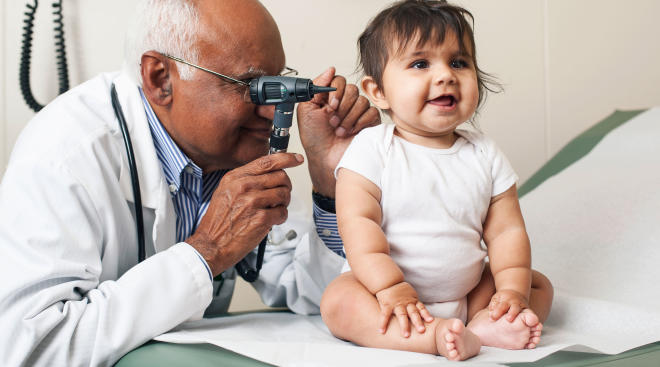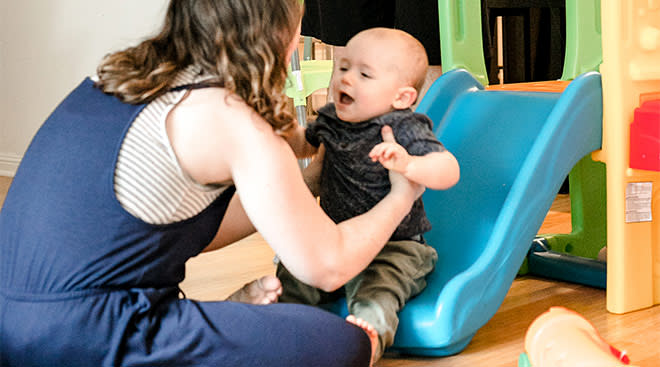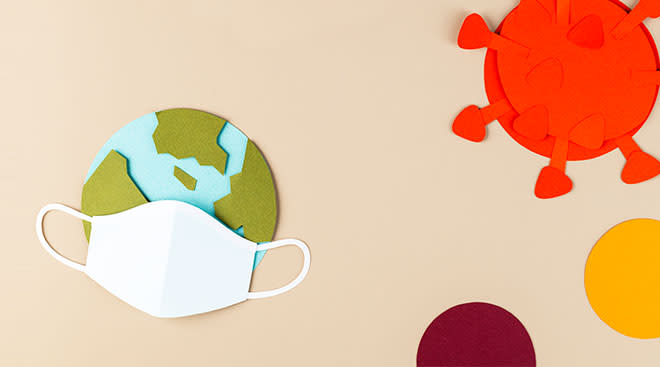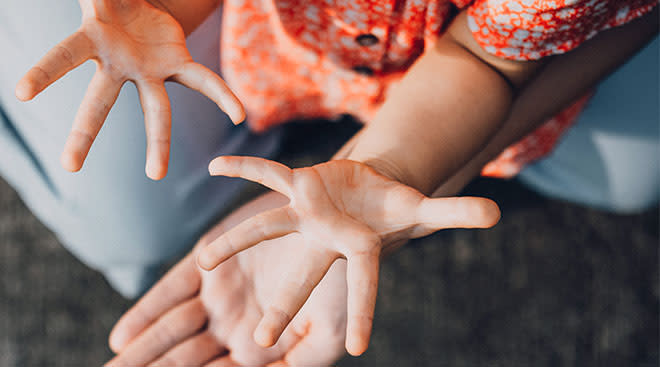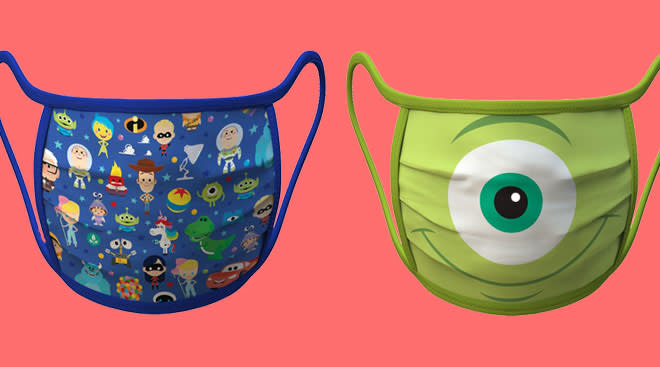How the Pandemic Is Affecting Little Ones’ Behavior (and What to Do)
The saying “the days are long and years are short” couldn’t feel truer today. In the era of COVID-19 quarantines and social distancing, hours and days are like a big, brown lump of Play-Doh, no longer separated by distinct colors. While some kids are basking in the extra family time (the silver lining on a cloud for some parents), others are facing thunderstorm-like challenges that manifest in behavioral changes and outbursts.
A spike in recurring meltdowns, sleep struggles, potty training regression and intense clinginess are some behaviors parents have been noticing more in the last few months—which can then spur a new wave of anxiety for parents. “It’s not just that parents exhibit stress that produces stress in kids,” says Daniel Bagner, PhD, a board-certified licensed clinical child psychologist and psychology professor at Florida International University’s Center for Children and Families. “Stress in kids, which may look different, may in turn lead to more stress on the parent. It’s not a one way street.”
In short, we’re anxiety conductors (whether we like it or not)—but that doesn’t mean that you have to be a perfect parent. The weight of emotional labor is real. Instead, embrace the concept of “good enough” parenting. “Every adult is going to have a moment when they get overwhelmed. That’s okay,” says Darlene A. Kertes, PhD, director of developmental psychology at the University of Florida. In fact, research shows that “getting it right” just 50 percent of the time is enough to have a positive impact on your child.
You can do this. Here, a look at some common pandemic-induced issues, along with new coping strategies for these tumultuous times. Get ready to flatten the challenging behaviors curve.
Challenges with little ones’ sleep schedules (and sleep battles) are as old as time, and it’s no different during the pandemic. Parents are seeing all sorts of changes to their child’s once-great sleep routines. “My 3-year-old daughter has always been a great sleeper,” says Brittny D. “That is, until about a month into being quarantined. All of a sudden, she was waking up multiple times each night, with inconsolable crying and repeatedly saying, ‘I need you.’" Another mom, Danielle F., says, “since week one of the stay-at-home orders, our 19-month-old cut his naps in half and he’s been getting up for the day in the 4 a.m. hour.”
In the fray, these behaviors can lead to other sleep routine shifts for parents like co-sleeping, cradling to sleep, repeated bedroom exits and having to sit next to your child’s crib (and potentially stroking their back) until they fall asleep—all utterly exhausting scenarios.
What You Can Do
Consider that these sleep changes could have happened regardless of the pandemic. Babies don’t start getting into a sleep rhythm until they’re at least 3 months old, and that rhythm continually adjusts as they go from three to two to one nap a day. “A lot of these changes in sleep are naturally occurring,” says Kertes. “We don’t want to overthink every case.”
However, one big reason your little one isn’t slumbering as well might be because they feel unsafe or afraid (this is true for adults too). Even minor adjustments like a new bedtime routine can cause suspicion that something isn’t right.
Before bedtime, ask if there was anything they didn’t like about their day. “Parents know their kids the best,” says Bagner. “Any behavior or response that seems out of the ordinary or different in intensity is worth noting.” Reassure your child that they’re safe, and maybe even console them by saying a toy they like to sleep with will keep worries away.
Another sleep disruptor could be your child’s lack of outdoor time. “We need sun exposure,” Kertes explains. “Sun helps reset our circadian clock.” If your child is used to playing outside and isn’t getting that sunshine cue now, it can mess with their sleep (not to mention all the energy they aren’t burning by climbing at the playground). Research shows that when natural sunlight hits the eye, it resets our internal clock—so even if you can’t go out, open up all the curtains and prop your toddler near the biggest window as you feed them breakfast. If you do have a backyard, consider stocking up on active toys (think: toddler trampoline!) or creating an obstacle course to get all those wiggles out.
If you can take on one task, it should be to protect your child’s sleep, as it’s the ultimate harbinger of good things. Anyone with a sleep-deprived toddler knows that fatigue goes hand-in-hand with crankiness. (Read on to learn how to tackle tantrums.)
Are you noticing that your generally sweet toddler is suddenly losing it over every tiny thing? “Anger is a secondary emotion,” says Kelly Oriard, a family therapist and co-founder of Slumberkins, an emotional learning brand. “Which means it’s a feeling that covers up other feelings like grief and loss, anxiety and sadness. Toddlers just don’t have the language or skills to let us know exactly what’s bothering them, so they just let those feelings out.” That’s why even the little things—say a crumbling block tower—trigger a BIG response.
Know that meltdowns tend to start around 18 months, when toddlers realize that they can be their own boss. “They realize they are their own separate person and begin to recognize themselves,” Kertes. “Around age 2 and definitely 3, they start saying no to you.” Take these normal developments and plop them into a situation where parents’ at-home demands have shifted and they have a new set of expectations from how things should be—and voila! You’ve just created a recipe for Blow Up Soup.
What You Can Do
We’re naturally hardwired to focus on the negative—that’s why it’s so easy to get upset when our child is upset. What you want to do is flip the script and ignore negative behavior (to your best abilities). “Negative attention is still attention,” says Kertes. Keep an eye on your toddler to make sure they’re safe, but otherwise ignore them. (This might be a good time to do the dishes, perhaps while wearing noise-cancelling headphones.) Instead, focus the attention on praising good behavior, like thoroughly washing hands, since it instills a sense of pride in a toddler.
On the other hand, if ignoring a tantrum doesn’t work and you lose your cool, take this opportunity to teach saying, “I’m sorry.”
“It’s possible that your child may learn from that,” says Bagner. Just do any apologizing after the meltdown is over—anything you say in the midst of screaming is simply not processed. When the dust settles, Bagner suggests you can say something like, “Mommy was really frustrated, I’m sorry I raised my voice. It’s important to stay calm.”
Yes, your baby was crying before, but now it seems like they stepped it up a notch. “All babies cry; that’s how babies communicate,” says Bagner. “But if baby cries more frequently or with a lot more intensity, that suggests they may have challenges.” We don’t necessarily know what stress looks like for infants. But we do know that unpredictability in routine and inconsistency in parenting can affect their ability to regulate emotion—or what we know as stress.
Too much stress in a toddler results in a tantrum, as mentioned above. But frequent whining and crying is their literal cry for help. That’s why a seemingly good game with a sibling can result in a puddle of tears faster than you can ask, “what happened?”
What You Can Do
To keep babies quietly content, play the imitation game. According to a 2020 study from Lund University in Sweden, 6-month-old babies smile longer at adults who imitate them. Researchers believe that babies perceive imitators as more friendly, compared to adults who responded in other ways. Babies like it when you’re interested in them, and in turn create a stronger bond.
Since sorting through toddler emotions is worse than organizing the artwork drawer, calming toddlers may take a bit more work. Mental stress triggers physical reactions, like a surge in cortisol and a faster heart beat, contributing to feeling overwhelmed. You won’t find your toddler sitting in lotus pose meditating, so it’s up to you to introduce techniques that can help them calm down, like belly breathing (show them how Elmo does it here) or reading books that help little kids deal with emotions.
Pausing is another way for your toddler (and you) to slow down and think about their emotions. “Paired with eye contact, pausing empowers little ones,” says Angela C. Santomero, author of Preschool Clues: Raising Smart, Inspired, and Engaged Kids in a Screen-Filled World who pioneered the ‘pause’ in children’s programming with Blue’s Clues almost 25 years ago. “It boosts their self-esteem and enables them to have the time to think, put their thoughts together and then give us their point of view. If we jump in too soon, we either answer the question for them or disempower them, and kids can get more frustrated when they don’t feel heard.”
Your Child Needs You. All. The. Time.
“The biggest change in my 1-year-old daughter is clinginess,” says mom Shari E. “Before lockdown, she was very independent. She would keep herself occupied for stretches of time. Now, if I leave the room, it often turns into a tantrum. I have also noticed that when we’re around people when going for walks, not in our ‘bubble,’ she becomes extremely shy and even overwhelmed. This has never been the case before shelter in place started.”
Parents may also see a spike in separation anxiety—which may seem surprising, given that we’re around each other all the time. But it actually makes sense. Think of it this way: When babies start to crawl, typically between the ages of 6 and 10 months, they’re equally thrilled and terrified about their newfound mobility and the fear of getting lost, says Kertes. But this thrill/fear is balanced by the parent’s presence as a harbor of safety. But if a parent is feeling restless, the child might sense it as a signal that if their parent is anxious, they need to be more vigilant too.
What You Can Do
Don your best Goldilocks persona (aka find just the right amount of balance) to help your toddler warm up to new situations like having to wear a face mask while out on a walk or seeing people in masks on the street. You don’t want to dismiss visible discomfort or fear, but at the same time you don’t want to layer on stress by teaching them to be afraid of something (like germs!). “Give them time to observe, then let them see for themselves that there’s nothing dangerous,” suggests Kertes. “Give your child a bit of wiggle room.”
One caveat: If you’re undergoing extreme stress or depression, make sure to pass the baton to your partner, at least for now. Infants, in particular, are at the age where they’re forming their world view, and an overly anxious parent can impact their idea of secure attachment in a significant (and negative) way. The good news? Babies and toddlers will be just fine as long as there’s one adult who they feel secure with, says Kertes. Don’t feel that you have to work through this difficult time on your own—seeking emotional support is a win-win for everyone.
Technology seems to be the saving grace of this pandemic, what with Zoom meetings, FaceTime and oh-so-much TV time, and it seems like screen time is a constant. The American Academy of Pediatrics recommends no screen time for babies under 18 months old; limited, educational programming for kids starting at 18 months; and a maximum of one hour of screen time a day for 2- to 5-year-olds—but admittedly these are not normal times.
No one will argue that the babysitting capabilities of screens are excellent, but what if your toddler expects to watch TV or play on a tablet all the time? “I had a few back-to-back meetings and had to rely on Netflix to keep my 3-year-old occupied for a couple of hours,” says Elena M. “Now when I pull out my laptop, he immediately asks for Masha and the Bear.”
What You Can Do
First of all, not all media and app use is bad, so don’t let your toddler’s newfound obsession with ABCmouse make you feel guilty. Age-appropriate screen time is okay, says Bagner, who co-authored a systematic review of nearly 1,500 studies on interactive apps in the journal Pediatrics. Research points out that educational apps can, in fact, improve cognitive skills, especially when it comes to numbers.
Not sure what counts as “smart” media use? When choosing electronic entertainment, seek shows and apps that inspire kids to “view” and then “do.” Meaning: Go outside after watching Peppa Pig and ask your toddler to play out parts of the episode, like puddle jumping. For insights into which programs are considered quality educational content, look to CommonSenseMedia.org, a researched-backed nonprofit site that reviews and ranks digital content.
What’s more, relying on our screens as a way to communicate with loved ones is one of the things that has helped alleviate the burden of isolation during the pandemic. “Just because a child is talking to grandparents on a screen, it’s not necessarily a bad thing,” says Bagner. “They are getting interactions with other people.”
Treat media use as you would sweets. You wouldn’t leave your toddler unattended with chocolate frosting-covered cake, but a pack of chocolate-flavored fiber crackers is a different story. As with everything, balance is key.
Your own screen time behavior is the classic case of “monkey see, monkey do.” If you’re forever on your iPad or frequently checking your phone (those group text chains don’t just answer themselves, am I right?), kids will start to view having one eye on the screen and one foot in the real world as normal behavior. “Differentiating work time from non-work time is really important,” adds Santomero. Find an area of the house for your phone and computer to demonstrate that screen time is not just a way to fill up time in general.
Maybe you were weaning your baby or had just about figured out potty training, and then—boom! In the course of a few weeks, all the progress you and your kiddo both made is not only unraveling, but perhaps taking a turn for the worse.
Think about it: Toddlers simply don’t have control over their lives. Pretty much every step of their life is controlled by you. And when control is out of their hands, Kertes explains, what best gives them a sense of security is predictability—which has been hard to come by during the pandemic. So when you suddenly throw in abrupt changes, like seeing their friends on Zoom instead of daycare circle time, that can further stir up their pot of emotions. They react by clinging to whatever feeling of control they can muster.
What You Can Do
Behavior regression is a way to exert control—something we all have very little of during an uncertain time. Create a feeling of control by letting your child choose an outfit or decide on a snack, suggests Kertes. And when lifestyle changes pop up, try to make them as routine as possible. That way your child will feel as if they’re a key player, not just a pawn.
“Try to refrain from any type of ‘pushing’ your children to get back to what they were doing before,” says Oriard. “If your child begins wanting more snuggles, wants to nurse again and wants to sleep with you, it’s likely they’re trying to seek nurturing and comfort. With trust and nurturing, your child will likely get ‘back on track.’” Truth be told, we could probably all use a bit more snuggle time right now.
About the experts:
Daniel Bagner, PhD, is a board-certified and licensed clinical child psychologist and psychology professor at Florida International University’s Center for Children and Families. His main research interests are in the development and evaluation of psychosocial interventions for early childhood behavior problems. He earned his PhD in clinical psychology at the University of Florida in Gainesville.
Darlene A. Kertes, PhD, is the director of developmental psychology at the University of Florida. She investigates the effects of parenting and life experiences on children’s biological stress responses. She completed her PhD in child psychology at the Institute of Child Development at the University of Minnesota.
Kelly Oriard is a family therapist and co-founder of Slumberkins, an emotional learning brand. She has a dual master’s degree in marriage and family therapy and school counseling from Portland State University.
Please note: The Bump and the materials and information it contains are not intended to, and do not constitute, medical or other health advice or diagnosis and should not be used as such. You should always consult with a qualified physician or health professional about your specific circumstances.
Angela C. Santomero is co-creator of Blues Clues and the author of Preschool Clues: Raising Smart, Inspired, and Engaged Kids in a Screen-Filled World. Plus, more from The Bump:
Navigate forward to interact with the calendar and select a date. Press the question mark key to get the keyboard shortcuts for changing dates.
































